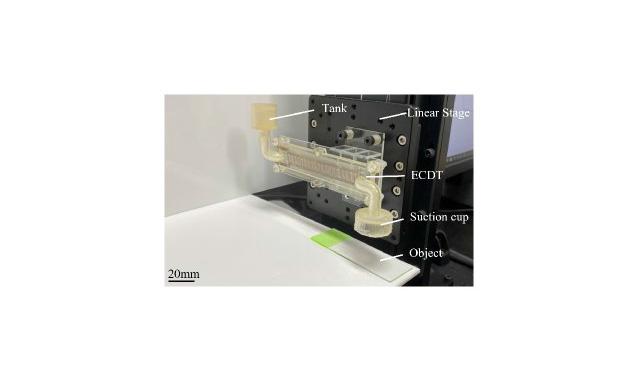A 2in1 sensor for fluid detection driven by electrochemical reaction is developed.
The research team of Professor Maeda Maeda and doctoral student Yuku Morijima of the Department of Mechanical functional Engineering, Department of Engineering, Shiraura University of Technology (Tokyo Port area / President Jun Yamada), designed an electrochemical dual sensor (ECDT) with electrochemical reaction as the power source, which can successfully drive and detect the fluid of a soft robot without complex components.
The installation of sensors on soft robots is expected to achieve multi-functions, but the complexity and large-scale wiring is a topic. Through the development of ECDT, we can work through self-induction to achieve mute, small, lightweight. In addition, the production of ECDT does not require any special equipment or complex processing.
※この研究成果は、「ACS Applied Materials & Interfaces」誌オンライン版に掲載されています。
< main points >
A simple, light, mute and inductive pump and electrochemical dual sensor (ECDT) have been developed.
Evaluate the sensing performance, and further reveal the sensing mechanism through mathematical modeling.
Using ECDT to make the action of self-sensing actuator of soft robot possible.
Picture. Empirical experiment of ECDT-driven sucker (courtesy of Professor Maeda)
Research background
In recent years, soft robots made of soft materials called elastomers have attracted much attention because of their high adaptability and safety to human daily life. However, in the fluid system used by soft robots, large, heavy and noisy pumps are used as driving sources.
The research team, which aims at the small design and mute drive of soft robots, has produced a lot of research results so far. The Electrohydrodynamics (EHD) pump is published, which produces flow in the medium body fluid by electrochemical reaction. In recent years, telescopic EHD pumps with soft electrodes have been developed to realize the softening of robot systems including driving sources. In addition, a flexible simple digital production method of EHD pump is established.
The next challenge is to develop soft robots that are both functional and miniaturized. In this study, we propose a simple, lightweight, silent and sensable pump and electrochemical dual transducer (ECDT) based on electrochemical reaction, which makes it possible to work with soft robots using ECDT.
Summary of research:
The team successfully drove the "self-inductive" soft robot, which uses electrochemical dual sensors (ECDT) to sense the flow of the fluid, thereby activating the electrochemical reaction and increasing the current. Through the installation of sensors on the soft robot, the multi-function of the robot continues to develop, but a lot of wiring has become complex and fat. ECDT's self-sensing actuation technology solves this problem and makes the soft robot miniaturized.
The design of ECDT is based on the previous EHD pump. The ECDT consists of a symmetrical arrangement of planar electrodes, and the flow direction can be easily controlled by changing the voltage. In addition, because the intensity of the left and right electric field is the same, the same amount of water can flow in both directions. The team evaluated the sensing performance such as detectable flow range, speed, sensitivity, response and relaxation time, and further clarified the sensing mechanism through mathematical modeling. In addition, it is also used to drive the sucker to detect objects, grasp and release objects, and verify their performance.
Research funding.

This study is funded by JSPS Research fee (18H05473) and Special researcher Award fee (21J23563).
Paper information:
Author: the PhD (later stage) course of Graduate School of Zhipu University of Technology
Guan Mengtai, Master Program of Graduate School of Zhipu University of Technology
Yamada Xionghei, Assistant Professor, SIT General Research Institute, Zhipu University of Technology
The Master course of Graduate School of Zhipu University of Technology
Sangtai Tanuchi, Master's Program of Graduate School of Zhipu University of Technology
Ph. D. (later) course, Graduate School, Zhipu University of Technology, Ardi Wiranata
The Master's Program of Graduate School of Zhipu University of Technology
Zhong Zong Hongyi, Associate Professor, Department of Electrical Engineering, Department of Engineering, Zhipu University of Technology
Maeda Maeda, Professor of Mechanical and Mechanical Engineering, Department of Engineering, Zhipu University of Technology
Title: Electrochemical Dual Transducer for Fluidic Self-Sensing Actuation
掲載誌:ACS Applied Materials & Interfaces
DOI:10.1021/acsami.1c21076
Zhipu University of Technology refers to
Department of Engineering / Department of Systems Science / Department of Design Engineering / Department of Architecture / Graduate School of Science and Engineering
Https://www.shibaura-it.ac.jp/
It is a science and engineering university with only a handful of global education sent by overseas students in Japan and industry-university-research cooperative research activities participated by a large number of students. There are three campuses in Tokyo and Saitama (Zhipu, Fengzhou and Oya), with 4 departments and 1 research department, with about 9,000 students and about 300 full-time teachers. In 2027, the 100th anniversary of its founding, we will aim at the top 10 Asian universities of science and technology and devote ourselves to education, research and social contribution.
